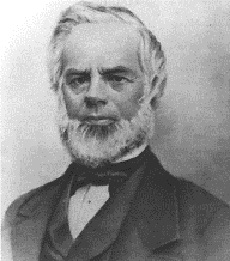<Back to Index>
- Mesmerist and Philosopher Phineas Parkhurst Quimby, 1802
- Author and Philosopher Warren Felt Evans, 1817
PAGE SPONSOR

Phineas Parkhurst Quimby (February 16, 1802 – January 16, 1866), was a New England philosopher, magnetizer, mesmerist, healer and inventor, who resided in Belfast, Maine, and had an office in Portland, Maine. Quimby's work is widely recognized as leading to the New Thought movement.
Born in the small town of Lebanon, New Hampshire, Quimby was one of seven children and the son of a blacksmith. As was customary for his social and monetary status at that time, Quimby received little formal education. He suffered greatly from 'consumption' in his youth and was prescribed calomel by his doctor. Instead of curing his sickness, the calomel began to rot his teeth, and Quimby began experimenting with his own ideas for a cure. He found that intense excitement (such as galloping on his horse) alleviated his pain for brief periods of time, and became interested in the mind's ability to affect the body. It is unclear how he found his ultimate cure, but it was through his own devices, and not from the doctor's medicine.
When Charles Poyen, a French mesmerist following in the tradition of Puységuer, came to Belfast, Maine, on a lecture circuit about mesmerism around 1836, Quimby was intensely curious. Quimby attended one of Poyen's lectures in 1838, and immediately began plying the mesmerist with questions about the nature of animal magnetism and its powers. Poyen admitted that with proper training, anyone could become adept at administering hypnotism. Quimby left his job as watchmaker and followed Poyen's tour of New England for the subsequent two years (1838 – 1840), until he became proficient at applying mesmeric hypnotism himself. Around this time Quimby's encountered Lucius Burkmar, an uneducated youth who was particularly susceptible to hypnosis. Quimby and Lucius began a tour of their own, practicing mesmeric demonstrations in front of large crowds.
Quimby
was a watch and clockmaker by trade and held several
patents for mechanical devices.
Julius and Annetta Dresser had both been cured by Quimby, from what sickness it is unclear. Their son, Horatio, wrote extensively on Quimby's theories, collecting many of Quimby's papers in his book Health and the Inner Life: An Analytical and Historical Study of Spiritual Healing and Theories, and also in the book, The Collected Manuscripts of P.P. Quimby.
Warren Felt Evans was one of the first individuals who wrote seriously on the teachings of Phineas Quimby.
Mary Baker Eddy, the founder of Christian Science, is often cited as having used Quimby as inspiration for theology. Most scholars agree that Christian Science does reflect Quimby's teachings. For a time Eddy was a patient of Quimby’s and shared his view that disease is rooted in a mental cause. But as her understanding of Christ Jesus’ approach to healing developed over the years, her concept of life and healing grew further and further away from Quimby’s. Because of its theism, Christian Science differs from the teachings of Quimby.
The
name Phineas Quimby appears in Vladimir Nabokov's novel
Lolita in a list of names that Humbert Humbert reads in
hotel registries during his frantic search for Lolita
after she is lost. The listing appears as "Phineas Quimby,
Lebanon, New Hampshire."

Warren Felt Evans (December 23, 1817 - 1889) was an American author of the New Thought movement. He became a student of the movement in 1863, after seeking healing from its founder, Phineas P. Quimby. He was the founder of a mind cure sanitarium in Salisbury, Massachusetts, and has been referred to as "the recording angel of metaphysics".
Born in Rockingham, Vermont, Evans was sixth of seven children. After studying at Chester Academy he entered Middlebury College in 1837, transferring the next year to Dartmouth College. He left in the middle of his junior year for financial reasons. He married M. Charlotte Tinker two years afterwards in 1840.
Evans became a Methodist minister in 1838, serving eleven different charges until 1863. That year he left the Methodists and joined the Church of the New Jerusalem after reading the books of Emanuel Swedenborg.
In 1863, Evans went to Portland, Maine, to find healing in the philosophy and methods of Phineas P. Quimby. Soon after, with Quimby's permission, he opened a mental medicine office in Claremont, New Hampshire. He and his wife opened an office in Boston. They practiced and informally taught the principles of mental healing there for 20 years.
Charles Braden, a metaphysical historian, wrote that
Evans, "was the only important figure, aside from Mrs.
Eddy, who attempted to work out a consistent and
philosophically supported system of metaphysical healing
and mental healing after Quimby."
Evans was the first to write about the New Thought movement began by Quimby. His first book was published six years after Quimby died, and he continued writing for the rest of his life.
- (1869) The Mental Cure (Illustrating the Influence of the Mind on the Body, Both in Health and Disease, and the Psychological Method of Treatment).
- (1872) Mental Medicine.
- (1875) Soul and Body.
- (1881) The Divine Law of Cure.
- (1885) The Primitive Mind Cure.
- (1886) Esoteric Christianity and Mental Therapeutics.